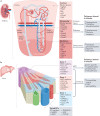Vascular endothelial cell development and diversity
- PMID: 36198871
- PMCID: PMC9533272
- DOI: 10.1038/s41569-022-00770-1
Vascular endothelial cell development and diversity
Abstract
Vascular endothelial cells form the inner layer of blood vessels where they have a key role in the development and maintenance of the functional circulatory system and provide paracrine support to surrounding non-vascular cells. Technical advances in the past 5 years in single-cell genomics and in in vivo genetic labelling have facilitated greater insights into endothelial cell development, plasticity and heterogeneity. These advances have also contributed to a new understanding of the timing of endothelial cell subtype differentiation and its relationship to the cell cycle. Identification of novel tissue-specific gene expression patterns in endothelial cells has led to the discovery of crucial signalling pathways and new interactions with other cell types that have key roles in both tissue maintenance and disease pathology. In this Review, we describe the latest findings in vascular endothelial cell development and diversity, which are often supported by large-scale, single-cell studies, and discuss the implications of these findings for vascular medicine. In addition, we highlight how techniques such as single-cell multimodal omics, which have become increasingly sophisticated over the past 2 years, are being utilized to study normal vascular physiology as well as functional perturbations in disease.
© 2022. Springer Nature Limited.
Conflict of interest statement
The authors declare no competing interests.
Figures



References
-
- World Health Organization. The Top 10 Causes of Death (WHO, 2020).
Publication types
MeSH terms
LinkOut - more resources
Full Text Sources
Other Literature Sources
Miscellaneous

